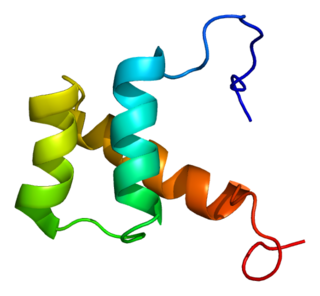
Mirtazapine, sold under the brand name Remeron among others, is an atypical antidepressant, and as such is used primarily to treat depression. Its effects may take up to four weeks, but can also manifest as early as one to two weeks. It is often used in cases of depression complicated by anxiety or insomnia. The effectiveness of Mirtazapine is comparable to other commonly prescribed antidepressants. It is taken by mouth.

A receptor antagonist is a type of receptor ligand or drug that blocks or dampens a biological response by binding to and blocking a receptor rather than activating it like an agonist. Antagonist drugs interfere in the natural operation of receptor proteins. They are sometimes called blockers; examples include alpha blockers, beta blockers, and calcium channel blockers. In pharmacology, antagonists have affinity but no efficacy for their cognate receptors, and binding will disrupt the interaction and inhibit the function of an agonist or inverse agonist at receptors. Antagonists mediate their effects by binding to the active site or to the allosteric site on a receptor, or they may interact at unique binding sites not normally involved in the biological regulation of the receptor's activity. Antagonist activity may be reversible or irreversible depending on the longevity of the antagonist–receptor complex, which, in turn, depends on the nature of antagonist–receptor binding. The majority of drug antagonists achieve their potency by competing with endogenous ligands or substrates at structurally defined binding sites on receptors.

Chlorprothixene, sold under the brand name Truxal among others, is a typical antipsychotic of the thioxanthene group.

Phenoxybenzamine is a non-selective, irreversible alpha blocker.
Antagonism is hostility that results in active resistance, opposition, or contentiousness.

Pipamperone, also known as carpiperone and floropipamide or fluoropipamide, and as floropipamide hydrochloride (JAN), is a typical antipsychotic of the butyrophenone family used in the treatment of schizophrenia and as a sleep aid for depression. It is or has been marketed under brand names including Dipiperon, Dipiperal, Piperonil, Piperonyl, and Propitan. Pipamperone was discovered at Janssen Pharmaceutica in 1961, and entered clinical trials in the United States in 1963.

Ketazocine (INN), also known as ketocyclazocine, is a benzomorphan derivative used in opioid receptor research. Ketazocine, for which the receptor is named, is an exogenous opioid that binds to the κ opioid receptor.

Captodiame (INN), also known as captodiamine, is an antihistamine sold under the trade names Covatine, Covatix, and Suvren which is used as a sedative and anxiolytic. The structure is related to diphenhydramine.

Homeobox protein DLX-2 is a protein that in humans is encoded by the DLX2 gene.

Benidipine is a dihydropyridine calcium channel blocker for the treatment of high blood pressure (hypertension). It is a triple L-, T-, and N-type calcium channel blocker. It is reno- and cardioprotective.

Xylamidine is a drug which acts as an antagonist at the 5HT2A receptor, and to a lesser extent at the 5HT1A receptor. It does not cross the blood–brain barrier, which makes it useful for blocking peripheral serotonergic responses like cardiovascular and gastrointestinal effects, without producing the central effects of 5HT2A blockade such as sedation, or interfering with the central actions of 5HT2A agonists.

Sarmazenil (Ro15-3505) is a drug from the benzodiazepine family. It acts as a partial inverse agonist of benzodiazepine receptors, meaning that it causes the opposite effects to most benzodiazepine drugs, and instead acts as an anxiogenic and convulsant. It is used in veterinary medicine to reverse the effects of benzodiazepine sedative drugs in order to rapidly re-awaken anesthetized animals.

17-Phenylandrostenol (17-PA), or (3α,5α)-17-phenylandrost-16-en-3-ol, is a steroid drug which binds to GABAA receptors. It acts as an antagonist against the sedative effects of neuroactive steroids, but has little effect when administered by itself, and does not block the effects of benzodiazepines or barbiturates.

Dazopride (AHR-5531) is an antiemetic and gastroprokinetic agent of the benzamide class which was never marketed. It acts as a 5-HT3 receptor antagonist and 5-HT4 receptor agonist. In addition to its gastrointestinal effects, dazopride facilitates learning and memory in mice.

LSD-Pip is a compound from the ergoline family, related to LSD but with the N,N-diethyl substitution replaced by a piperidine group. It is more potent than the corresponding pyrrolidine and morpholine analogues, but is still several times less potent than LSD as a 5-HT2A agonist. Early studies suggested this compound to be inactive as a psychedelic in humans, though this does not seem to have been confirmed by any more recent work.

CGP-35348 is a compound used in scientific research which acts as an antagonist at GABAB receptors.

Enprofylline (3-propylxanthine) is a xanthine derivative used in the treatment of asthma, which acts as a bronchodilator. It acts primarily as a competitive nonselective phosphodiesterase inhibitor with relatively little activity as a nonselective adenosine receptor antagonist.
A serotonin modulator and stimulator (SMS), sometimes referred to more simply as a serotonin modulator, is a type of drug with a multimodal action specific to the serotonin neurotransmitter system. To be precise, SMSs simultaneously modulate one or more serotonin receptors and inhibit the reuptake of serotonin. The term was created to describe the mechanism of action of the serotonergic antidepressant vortioxetine, which acts as a serotonin reuptake inhibitor (SRI), agonist of the 5-HT1A receptor, and antagonist of the 5-HT3 and 5-HT7 receptors. However, it can also technically be applied to vilazodone, which is an antidepressant as well and acts as an SRI and 5-HT1A receptor partial agonist.

6β-Naltrexol, or 6β-hydroxynaltrexone, is a peripherally-selective opioid receptor antagonist related to naltrexone. It is a major active metabolite of naltrexone formed by hepatic dihydrodiol dehydrogenase enzymes. With naltrexone therapy, 6β-naltrexol is present at approximately 10- to 30-fold higher concentrations than naltrexone at steady state due to extensive first-pass metabolism of naltrexone into 6β-naltrexol. In addition to being an active metabolite of naltrexone, 6β-naltrexol was itself studied for the treatment of opioid-induced constipation. It was found to be effective and well-tolerated, and did not precipitate opioid withdrawal symptoms or interfere with opioid pain relief, but development was not further pursued.

SB-228357 is a drug which acts as an antagonist for the 5HT2B and 5HT2C receptors. It has antidepressant and anxiolytic effects in animal models, and inhibits 5-HT2B mediated proliferation of cardiac fibroblasts.


















